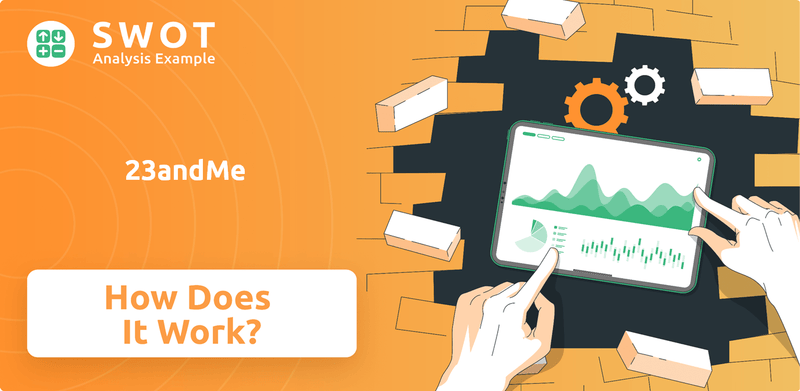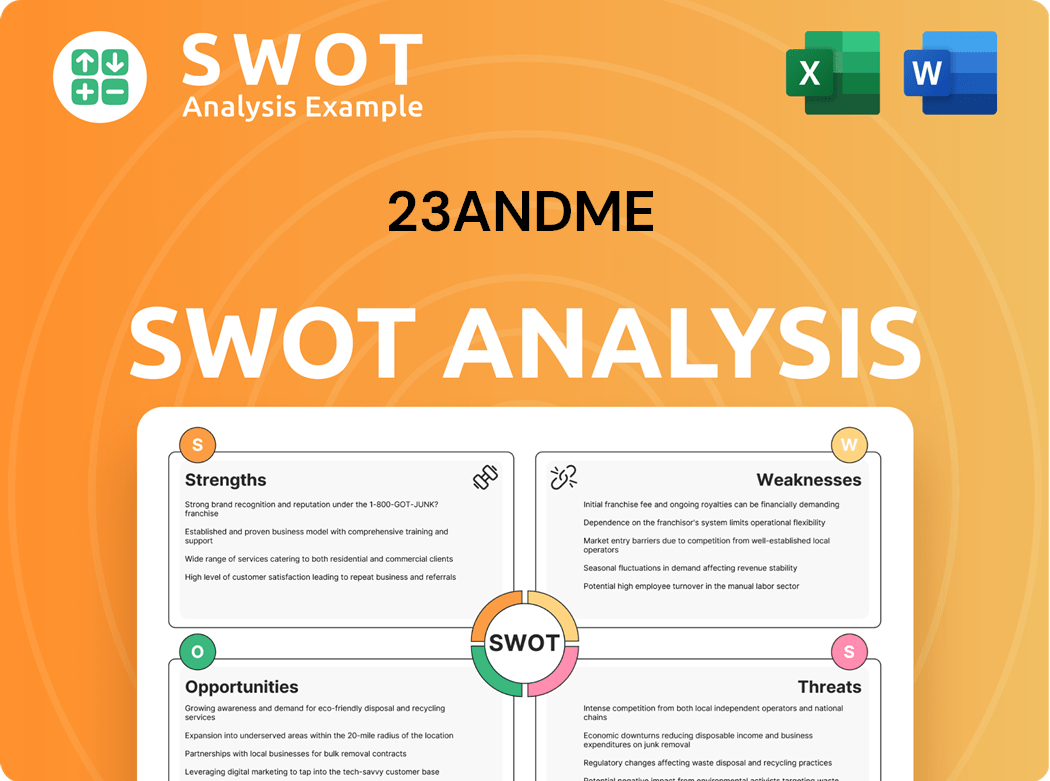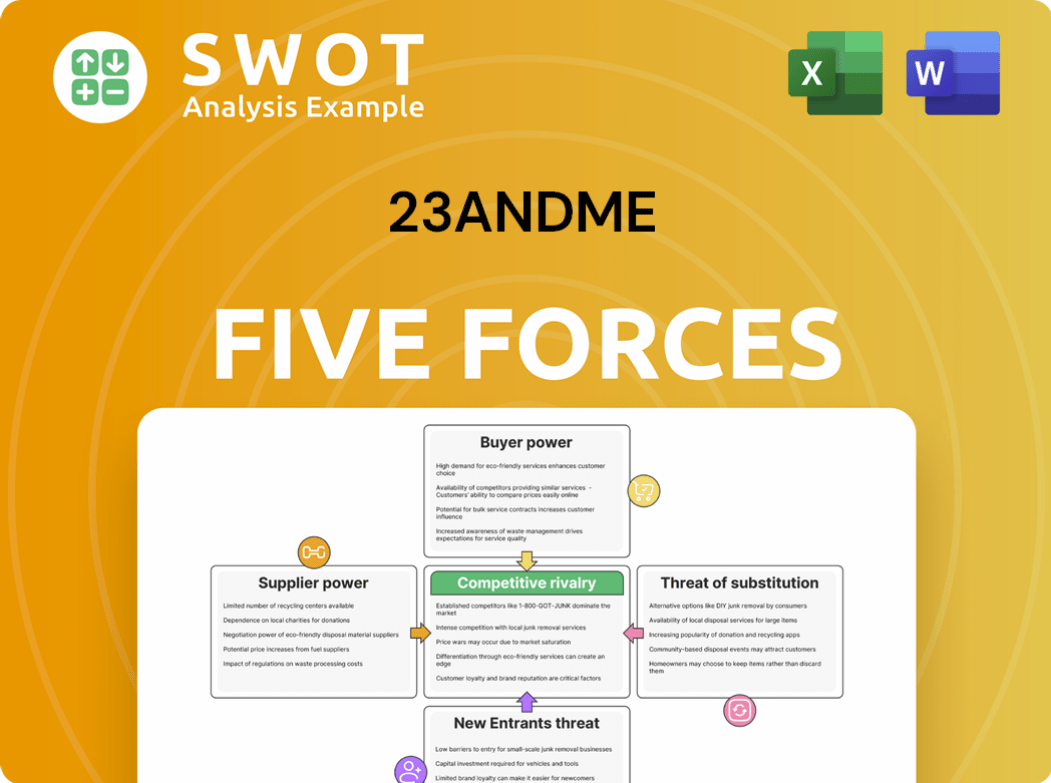23andMe Bundle
How Does 23andMe Revolutionize Personalized Health?
23andMe has fundamentally changed how we understand our health and ancestry, offering direct access to personal genetic information. By simply providing a saliva sample, individuals can unlock insights into their heritage and health predispositions, making it a leader in the 23andMe SWOT Analysis. This innovative approach has positioned 23andMe at the forefront of the personalized healthcare and genomics market, impacting millions globally. The company's dual focus on consumer services and pharmaceutical research sets it apart.

As of early 2024, understanding the intricacies of 23andMe's operations is crucial. This includes how 23andMe collects DNA, analyzes results, and generates revenue. Whether you're curious about 23andMe ancestry results accuracy, exploring 23andMe health reports explained, or comparing 23andMe vs. AncestryDNA, this analysis will provide valuable insights. We'll explore the company's strategic positioning and financial performance to provide a comprehensive understanding of its operations.
What Are the Key Operations Driving 23andMe’s Success?
The core operations of 23andMe revolve around providing direct-to-consumer DNA testing services. These services offer insights into ancestry, genetic health predispositions, and inherited traits. Customers purchase a kit, provide a saliva sample, and send it to a CLIA-certified and CAP-accredited lab for analysis.
The process involves extracting DNA, genotyping using SNP microarray technology, and bioinformatic analysis to generate personalized reports. These reports are delivered digitally, offering interactive tools and insights. The company's value proposition centers on empowering individuals with personal health knowledge and a deeper understanding of their heritage, as highlighted in the article Target Market of 23andMe.
23andMe has a significant advantage in its ability to process a high volume of samples efficiently while maintaining data privacy and security. Their extensive genetic database, built from millions of consented customer samples, is a critical asset. This data fuels both consumer services and therapeutics research, enabling more robust ancestry analysis and the discovery of novel genetic associations for health conditions.
23andMe offers two primary services: Ancestry + Traits Service and Health + Ancestry Service. The Ancestry service focuses on providing ancestry composition, DNA relative finder, and other ancestry-related features. The Health service includes reports on genetic health risks, carrier status, and wellness traits.
The process starts with customers providing a saliva sample using a 23andMe kit. The sample is sent to their CLIA-certified and CAP-accredited lab. DNA is extracted, genotyped using SNP microarray technology, and analyzed to create personalized reports. Results are delivered through a secure online platform.
The primary value for consumers is the empowerment of personal health knowledge and a deeper understanding of their heritage. This includes insights into ancestry composition, potential health risks, and carrier status for certain genetic conditions. Consumers gain actionable insights to make informed decisions about their health.
For the therapeutics arm, the value proposition is the accelerated identification of drug targets and patient cohorts for clinical trials. The extensive genetic database enables the discovery of novel genetic associations for health conditions, which can speed up the drug development process and improve the chances of success.
23andMe's operational uniqueness lies in its ability to process a high volume of samples efficiently while maintaining stringent data privacy and security protocols. The company has a large and growing database of genetic information.
- Data Privacy and Security: 23andMe emphasizes data security with encryption and secure storage.
- Partnerships: Collaborations with pharmaceutical companies, such as GSK, highlight the company's ability to translate genetic insights into potential therapeutic solutions.
- Database Growth: The company's database continues to expand, with millions of customers contributing to the data pool, enhancing the accuracy and scope of their services.
23andMe SWOT Analysis
- Complete SWOT Breakdown
- Fully Customizable
- Editable in Excel & Word
- Professional Formatting
- Investor-Ready Format

How Does 23andMe Make Money?
The revenue model of 23andMe centers around two main segments: Consumer & Research Services and Therapeutics. The company leverages its direct-to-consumer DNA testing kits, subscriptions, and partnerships with pharmaceutical companies to generate income. Understanding these diverse revenue streams is key to grasping the company's financial structure and growth potential.
23andMe's financial performance in fiscal year 2024, ending March 31, showed total revenue of $219.6 million. This highlights the importance of both its consumer-focused products and its strategic partnerships in the pharmaceutical sector.
The Consumer & Research Services segment earns revenue through the sale of DNA testing kits, such as the Ancestry + Traits Service and the Health + Ancestry Service. The Health + Ancestry Service is generally priced higher due to its inclusion of health-related reports. Additionally, the company generates revenue from subscriptions that provide personalized genetic insights and premium features.
The Therapeutics segment relies on collaborations and partnerships, particularly with pharmaceutical companies. This includes upfront payments, research funding, milestone payments, and royalties from drug candidates. The partnership with GSK, initiated in 2018, is a prime example of this strategy. The company is also exploring opportunities to monetize its platform through research studies, diversifying its revenue sources.
- The Therapeutics segment is a crucial long-term monetization strategy.
- Partnerships include upfront payments, research funding, and potential royalties.
- The company is focused on optimizing costs and improving profitability in both segments.
- 23andMe's innovative monetization strategies also include leveraging its platform for research studies.
The 23andMe business model is multifaceted, with revenue streams coming from both consumer products and partnerships. To learn more about the company's strategic direction, consider reading about the Growth Strategy of 23andMe.
23andMe PESTLE Analysis
- Covers All 6 PESTLE Categories
- No Research Needed – Save Hours of Work
- Built by Experts, Trusted by Consultants
- Instant Download, Ready to Use
- 100% Editable, Fully Customizable

Which Strategic Decisions Have Shaped 23andMe’s Business Model?
23andMe has navigated a complex path, marked by significant milestones and strategic shifts. A critical early success was securing FDA authorization in 2017 for its Personal Genome Service Health Predisposition Reports. This approval allowed the company to re-enter the health genomics market after facing regulatory hurdles. Another pivotal move was the establishment of its Therapeutics group in 2015, signaling a strategic pivot toward drug discovery and development, leveraging its extensive genetic database.
The company's journey has included operational challenges, such as regulatory scrutiny and the need for ongoing consumer education about the complexities of genetic information. During the COVID-19 pandemic, 23andMe adapted to shifts in consumer spending and supply chain disruptions by optimizing its processes and focusing on digital engagement. These strategic adjustments highlight its ability to respond to market dynamics.
23andMe's competitive advantages are rooted in its extensive proprietary genetic database, which is one of the largest in the world, and its strong brand recognition as a pioneer in direct-to-consumer genetic testing. The dual business model, which combines consumer services with a therapeutics arm, differentiates it from competitors. 23andMe continues to innovate by exploring new applications for genetic data and investing in research to expand its health reports and therapeutic pipeline.
The FDA authorization in 2017 was a crucial milestone, allowing 23andMe to provide health-related genetic information directly to consumers. The establishment of the Therapeutics group in 2015 marked a strategic shift toward drug discovery. The collaboration with GSK in 2018 provided significant funding and validation for its research capabilities.
The company's strategic moves include pivoting toward drug discovery and development. 23andMe has expanded its health reports and therapeutic pipeline. They have adapted to market changes by optimizing processes and focusing on digital engagement.
23andMe’s extensive proprietary genetic database is a major advantage. Strong brand recognition as a pioneer in direct-to-consumer genetic testing provides a competitive edge. The dual business model, combining consumer services with a therapeutics arm, differentiates it from competitors.
Regulatory scrutiny and the need for consumer education are ongoing challenges. The company adapted to the COVID-19 pandemic by optimizing processes and focusing on digital engagement. 23andMe continues to explore new applications for genetic data and invest in research.
23andMe operates on a dual business model, offering both consumer genetic testing services and a therapeutics arm. This model allows the company to generate revenue from direct-to-consumer sales and through partnerships in drug discovery. The company's market position is strengthened by its large genetic database and brand recognition in the DNA testing market.
- 23andMe's database contains data from over 14 million genotyped customers as of late 2023, making it one of the largest in the world.
- The company has a significant presence in the personal genomics market, competing with companies like AncestryDNA.
- 23andMe has faced challenges related to data privacy and security, which have impacted its operations. For more information, read this article about 23andMe.
- The company is actively involved in research and development, with a focus on leveraging its genetic data for drug discovery and personalized medicine.
23andMe Business Model Canvas
- Complete 9-Block Business Model Canvas
- Effortlessly Communicate Your Business Strategy
- Investor-Ready BMC Format
- 100% Editable and Customizable
- Clear and Structured Layout

How Is 23andMe Positioning Itself for Continued Success?
In the realm of direct-to-consumer genetic testing, 23andMe holds a significant position, contending with rivals like AncestryDNA and MyHeritage. The company is recognized for its established brand and comprehensive offerings, which drive strong customer loyalty. 23andMe's global footprint spans numerous countries, with the United States as its primary market, and it is a key player in the DNA testing industry.
The company faces several risks and challenges, including evolving regulations concerning data privacy and the scope of health reports, intense competition, and technological advancements. Strategic initiatives include expanding its therapeutic pipeline, seeking new pharmaceutical partnerships, and enhancing consumer product offerings. 23andMe aims to leverage its genetic database for both consumer empowerment and drug discovery, capitalizing on the growing interest in personalized health and genomics. You can learn more about the company's ownership at Owners & Shareholders of 23andMe.
23andMe is a prominent player in the genetic testing market, competing with AncestryDNA and MyHeritage. It has a strong brand and comprehensive offerings. The company's global reach is extensive, with a significant presence in the US.
Evolving regulations regarding data privacy and health reports pose a challenge. Intense competition from new and established players is another risk. Technological disruptions and changes in consumer preferences could also impact the business. These factors influence the future of 23andMe.
Strategic initiatives include expanding the therapeutic pipeline and forming new partnerships. The company is focused on enhancing consumer product offerings and improving financial performance. The goal is to leverage the genetic database for consumer empowerment and drug discovery.
As of Q1 2024, 23andMe reported a revenue of approximately $69 million. The company is working towards profitability. The market for Health and Personal genomics continues to grow, creating opportunities for 23andMe.
23andMe is focused on expanding its therapeutic pipeline and forming new pharmaceutical partnerships. The company is also working on enhancing its consumer product offerings and improving financial performance. These strategies aim to drive growth and capitalize on the increasing interest in personalized health.
- Expanding the therapeutic pipeline to discover new drugs.
- Forming partnerships to leverage expertise and resources.
- Enhancing consumer product offerings with more insights.
- Improving financial performance and achieving profitability.
23andMe Porter's Five Forces Analysis
- Covers All 5 Competitive Forces in Detail
- Structured for Consultants, Students, and Founders
- 100% Editable in Microsoft Word & Excel
- Instant Digital Download – Use Immediately
- Compatible with Mac & PC – Fully Unlocked

Related Blogs
- What are Mission Vision & Core Values of 23andMe Company?
- What is Competitive Landscape of 23andMe Company?
- What is Growth Strategy and Future Prospects of 23andMe Company?
- What is Sales and Marketing Strategy of 23andMe Company?
- What is Brief History of 23andMe Company?
- Who Owns 23andMe Company?
- What is Customer Demographics and Target Market of 23andMe Company?
Disclaimer
All information, articles, and product details provided on this website are for general informational and educational purposes only. We do not claim any ownership over, nor do we intend to infringe upon, any trademarks, copyrights, logos, brand names, or other intellectual property mentioned or depicted on this site. Such intellectual property remains the property of its respective owners, and any references here are made solely for identification or informational purposes, without implying any affiliation, endorsement, or partnership.
We make no representations or warranties, express or implied, regarding the accuracy, completeness, or suitability of any content or products presented. Nothing on this website should be construed as legal, tax, investment, financial, medical, or other professional advice. In addition, no part of this site—including articles or product references—constitutes a solicitation, recommendation, endorsement, advertisement, or offer to buy or sell any securities, franchises, or other financial instruments, particularly in jurisdictions where such activity would be unlawful.
All content is of a general nature and may not address the specific circumstances of any individual or entity. It is not a substitute for professional advice or services. Any actions you take based on the information provided here are strictly at your own risk. You accept full responsibility for any decisions or outcomes arising from your use of this website and agree to release us from any liability in connection with your use of, or reliance upon, the content or products found herein.